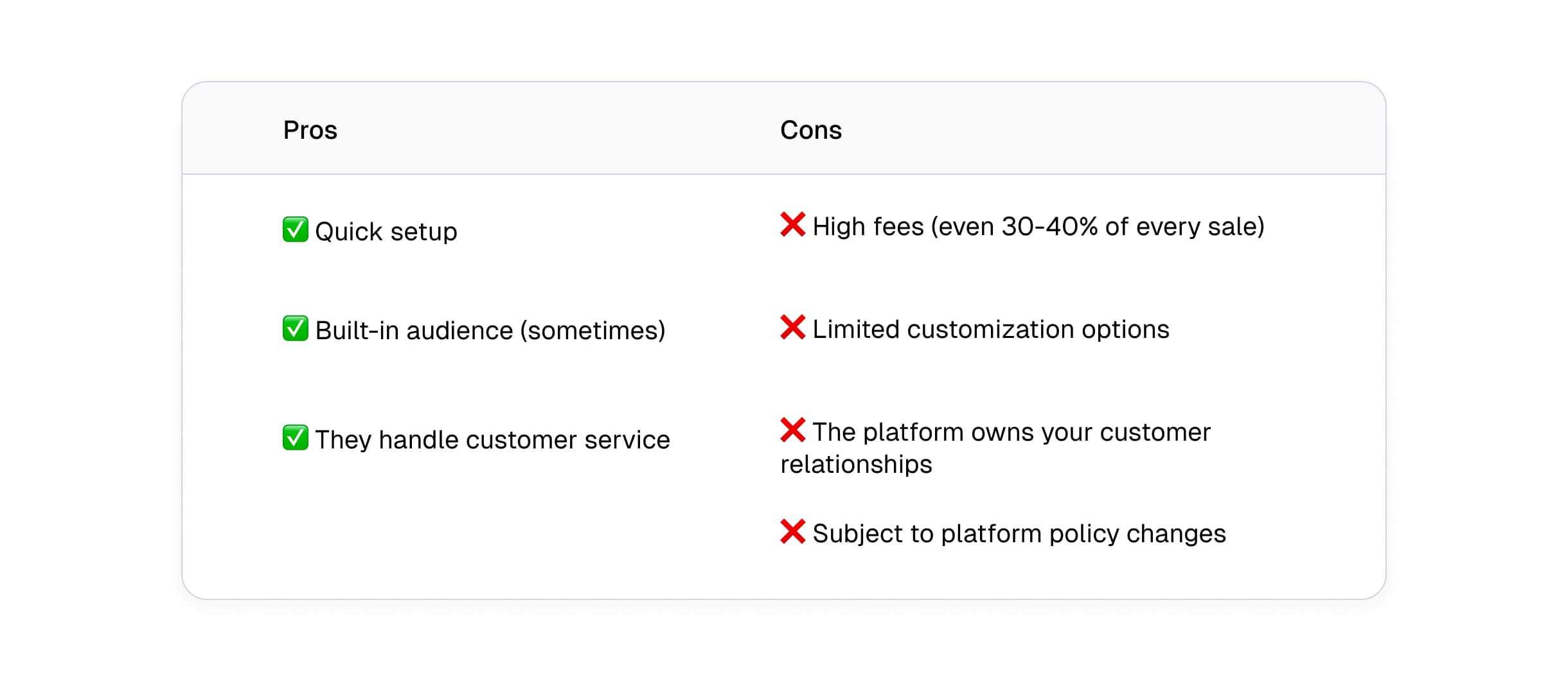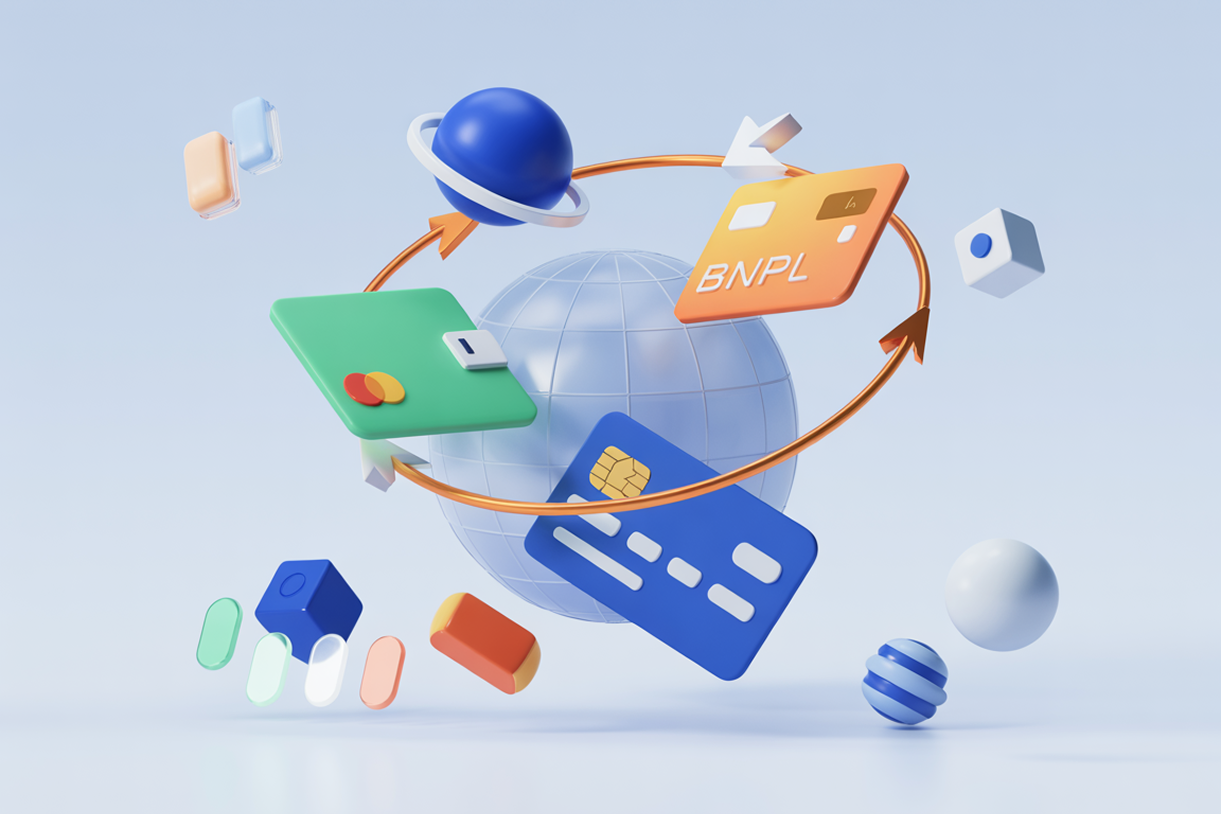How to accept payments online: A creator's guide
Learn how digital creators and solopreneurs can simplify online payments with a platform built for their needs – no tech headaches, just seamless selling.

As a digital creator, online freelancer or solopreneur, you need one thing to complete a transaction on your website — a way to get paid.
Putting this last piece of the puzzle into place is a headache for many because navigating the world of online payments can feel overwhelming. You know you need a way for customers to pay, but seeing terms like payment gateways, merchant accounts, processors and others can make it sound like a job for an IT department that you don't have.
The truth is, while the process is complex behind the scenes, you don't need to be a tech wizard to get it right — you just need a quick payments solution built for your needs.
Accepting payments online, simplified
The process of accepting electronic payments involves a few key players:
- Your customer - They're on your website, ready to buy.
- The payment gateway - This is the customer-facing "checkout counter" of your website. It's the technology that securely captures their payment information and sends it to the next step.
- The payment processor - This is the behind-the-scenes go-between. The processor takes the encrypted information from the gateway and communicates with the customer's bank and your bank to verify the transaction.
- The banks - The customer's bank approves or declines the charge, and if approved, the funds are sent to your bank.
- Your business account - The finish line for your money, minus any fees (we'll get to that later).
The challenge for small creators: Setting up each piece individually means dealing with merchant accounts, security compliance, hidden fees, and complex integrations - often with long-term contracts that aren't optimized for one-person businesses.
Why popular options to take payments online fall short for creators
Traditional online payment systems were built for large-scale e-commerce with huge transaction volumes, not solo creators. Here's what that means for you:
The hidden problems
- Payment processing costs: You might face a mix of per-transaction fees, monthly fees, and even surprise charges for things like chargebacks. These costs can eat into your profit margins, especially on smaller-ticket items.
- Complex setup: The process often involves a lot of paperwork, technical integration, and a long onboarding process that can take weeks, not minutes.
- Lack of flexibility: They're often rigid, designed for a single type of transaction. As a creator, you might need to accept one-time payments, recurring payments, and even offer payment plans. A traditional system might not handle all of that well.
- Compliance burden: Dealing with things like PCI DSS compliance (a set of security standards for handling card data) is a huge burden for a solo operator.
The bigger risks
Unfortunately, those aren't the worst of the problems. Many solutions marketed at creators can expose you to two very significant risks:
- Platform dependency: Relying on certain traditional payment providers can put you in a tough position. If that platform changes its policies, increases its fees, experiences technical issues or even decides to suspend your account (sometimes without clear reason), your income stream can be instantly disrupted.
- Merchant of Record (MoR) issues: While using MoR is nice when it's time to deal with taxes (their problem, not yours), MoR model also has some serious drawbacks. For starters, their name, not yours, appears on your customer's bank statement. This can confuse customers and means the platform legally owns the customer relationship for the payment process. Also, if you ever decide to switch platforms, migrating your customer payment information and subscription relationships can be incredibly difficult.
Comparing your options for accepting online payments
Now let's dive deeper into the specific payment solutions you're likely considering. While these options might seem appealing at first glance, many of them suffer from the exact issues we just discussed – high fees, platform dependency, and limited control over your customer relationships.
Understanding the full picture is crucial before you commit. What looks like a simple, affordable solution today could become a major obstacle to your business growth tomorrow.
All-in-one selling platforms
All-in-one selling platforms are purpose-built solutions that let digital creators and solopreneurs launch, sell, and deliver products online – without any technical setup or coding. These platforms often focus on specific product type (e.g. courses) and handle everything behind the scenes, so you can focus on your content and audience.
Best for: Complete beginners who want everything handled for them

Bottom line: Great for testing ideas, but expensive for serious businesses.
What to consider:
- Fees: Most platforms charge a percentage of each sale, sometimes with extra fees for premium features or new-customer referrals. Plus, you also need to pay payment gateway fees.
- Customization: Branding and checkout options may be limited compared to direct integration.
- Platform dependency: Your business is tied to the platform's rules, policies, and long-term viability.
- Audience access: Some platforms offer built-in discovery features, but you may have limited access to customer emails and data for future marketing.
Direct payment processors
Direct payment integration means embedding the payment process directly into your website, allowing customers to pay without ever leaving your branded environment. That usually requires integration with a payment gateway or payment processing service. This approach provides a seamless, professional checkout experience and gives you more control over every aspect of online transactions.
Best for: Tech-savvy creators who want full control

Bottom line: Powerful but requires significant technical expertise and ongoing maintenance.
What to consider:
- Pricing & fees: Get a complete understanding of the costs associated with each transaction, monthly fees and other costs for onboarding, currency conversion, etc.
- Payment methods accepted: Verify that the provider accepts a range of methods, including credit cards, digital wallets, bank transfers, and multiple currencies.
- Integration capabilities: Check for ease of setup and simple implementation into your website, points of sale, your accounting software and any required custom solutions.
- Security & compliance: Confirm the use of measures for cardholder data security like PCI DSS, fraud detection and prevention features, data encryption and more.
Plugins for accepting payments
If you already have your own website – especially if it’s built on platforms like WordPress – payment plugins can be a simple way to start accepting payments without rebuilding your whole setup. These plugins integrate with your existing site, adding checkout functionality right where your audience already is.
Best for: Creators with an existing website built using Wordpress

What to consider:
- Compatibility: Make sure the plugin works with your current theme, hosting provider, and WordPress version
- Payment methods: Look for support for credit cards, digital wallets, and local payment options
- Security: Choose plugins that are PCI-compliant and regularly updated
- Support & documentation: Good plugins come with clear setup guides and responsive support, which can save you a lot of frustration in the long run
E-commerce platforms
E-commerce platforms allow you to create and manage online stores without needing extensive coding knowledge. They provide all the necessary tools and features to sell products or services online, making it accessible for everyone from new businesses and growing startups to hobbyists and dropshippers.
Best for: Creators selling physical products or with a large product portfolio

Bottom Line: Comprehensive but unnecessarily complex and expensive for digital creators.
What to consider:
- Ease of use: Most use a simple drag & drop editor as an interface but look into other issues like hosting & responsibility for updates
- E-commerce features: Check for options for digital product support, product delivery options, abandoned cart recovery, etc.
- Design & customization: Verify availability of templates & themes, design flexibility, branding options and responsiveness for mobile devices
- Marketing & SEO Tools: In addition to built-in features to increase your visibility, look for integrations with email marketing & social media as well as analytics capabilities
Accept payments on your website the Easytools way
{{cta-banner-1}}
Remember when we said that when it comes to ways to accept online payments, what you need as a solopreneur is a solution "built to your needs"? This is where Easycart steps into the spotlight.
Just set up your 100% FREE account, and you'll instantly gain access to:
An online payment system that offers:
- One-click payments and the ability to save customer data for future purchases
- All popular payment methods, including quick payments with local services, electronic fund transfers, and digital wallet payments
- All payment types – whether it's one-time payments, subscription billing, installment plans, or deferred payments
Creator tools to grow your business:
- Unlimited, fully customizable checkouts
- Drag-and-drop landing page builder
- Online player for launching your courses
- Automated features for collecting reviews
- 100% automatic subscription management
- And so much more!
With Easycart, you don't just take online payments; you get a complete creator ecosystem that has everything you need to sell digital products – all in one place, for one price.
4 common mistakes to avoid when choosing a payment solution
When selecting a way to accept online payments for your business, be aware of these four common mistakes that result from choosing what looks good now over the possible long-term effect on your e-commerce platform.
Mistake #1: Choosing based on transaction fees alone
It's tempting to focus just on the advertised percentage per transaction, but this is often just the tip of the iceberg. A seemingly low transaction fee can be overshadowed by a host of other costs that erode your profits:
- Hidden monthly costs: Many payment providers have tiered pricing or introduce fees for specific services that aren't immediately obvious. Some even have minimum monthly processing fees, meaning you pay a flat amount even if your transaction volume is low.
- Setup and maintenance expenses: Don't forget about any initial setup fees for integrating a payment provider. There might also be ongoing maintenance fees, PCI compliance fees (for adhering to Payment Card Industry Data Security Standards), or even fees for chargebacks (when a customer disputes a transaction). These can quickly add up and significantly impact your overall cost of doing business.
- Customer support time costs: While not a direct monetary fee, the cost of poor customer support can be substantial. If your payment system frequently experiences issues, or if getting help from your provider is a nightmare, you will spend valuable hours troubleshooting instead of focusing on sales or other core business activities. This can lead to frustrated customers, abandoned carts and a damaged reputation.
Mistake #2: Ignoring international customers
It's a big world and part of the point of selling online is to reach more customers, right? You might attract buyers from places way out of your time zone so a good payment solution should leave the door open for international expansion. If you're too quick to close that door, then you might be faced with these at some point down the road:
- Lost sales from currency confusion: If your website only displays prices and processes payments in your local currency, international customers will face uncertainty about the actual cost in their own currency. This can lead to cart abandonment, as shoppers are less likely to complete a purchase if they're unsure about the final amount or exchange rates. Offering multi-currency pricing and localized payment methods significantly increases conversion rates for international sales.
- Tax complications you didn't expect: You won't be surprised to learn that selling internationally involves complex tax regulations. Different countries have varying VAT rates, sales taxes, import duties and more. A payment solution that doesn't help you navigate these complexities can lead to unexpected tax liabilities, fines and administrative headaches. Look for providers that offer tools or integrations for managing international tax compliance.
Mistake #3: No plan for growth
What works for a small operation today might cripple a rapidly growing enterprise later. Choosing a payment solution without considering your future scale can lead to expensive and disruptive problems down the line:
- Platform limitations as you scale: A solution that can handle a few dozen transactions a day might crumble under the pressure of hundreds or more. Performance bottlenecks, slow transaction speeds and frequent downtime can lead to significant lost sales and a poor customer experience during peak periods, like holiday sales. Be sure your solution can scale seamlessly with your projected transaction volume.
- Migration costs and customer loss: If your initial payment provider can't keep up with your growth, you'll eventually face the unwelcome task of migrating to a new system. This process can be costly, time-consuming and carries the risk of data migration errors. More importantly, it can disrupt your checkout flow, leading to temporary customer frustration and even permanent customer loss if the transition isn't smooth.
Mistake #4: Overlooking customer data ownership
You've heard it a million times so one more won't hurt — data is the engine of e-commerce. How your selected payment provider handles and shares your customer data has serious implications for your business:
- Customer data is your most valuable asset: Beyond basic transaction details, customer data—like purchasing habits, preferences, demographics and more—is invaluable for personalized marketing, product development and improving the overall customer experience. If your payment provider retains significant ownership or rights to this data, you might be limited in how you can leverage it for your own business intelligence and growth strategies.
- Platform risks to your business: Relying on a payment platform that doesn't prioritize your data ownership can expose your business to various risks. This could include limitations on data portability (making it difficult to switch providers), potential data breaches or even the provider using your customer data for their own purposes or sharing it with third parties in ways you didn't intend. Pay attention to the terms and conditions regarding data ownership and privacy when selecting a payment solution.
By avoiding these four common mistakes, you can select a payment solution that not only meets your current needs but also supports your long-term vision, protects your profits and fosters strong customer relationships.
Ready to start taking payments online?
Setting up online payments as a creator doesn't have to be overwhelming. By choosing the right platform for your needs, you can start accepting payments almost immediately while avoiding the many issues associated with being locked into the wrong fit.
Selling your creations in the online space means you don't have a choice when it comes to accepting digital payments or not — no online payments means no online business. However, selecting your partner in how those payments are handled is completely up to you and Easycart is the perfect solution for the small creators that are driving modern e-commerce forward.
Get started today by clicking HERE and see just how easy your online selling experience can be!
Related articles
Ready for more? Check out these related articles that will keep your momentum going. They’re packed with easy-to-follow tips and tricks to help you supercharge your digital goods business.
Take it easy with Easytools
Focus on creating, and let Easytools handle the behind the scenes work.





